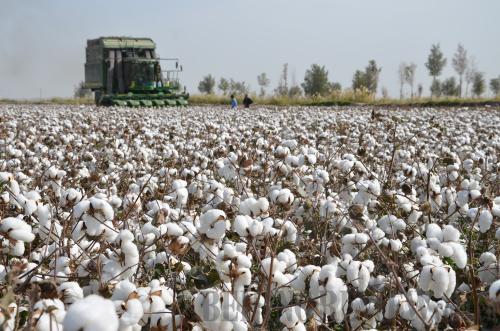|
 |
|
COTTON HARVEST: The use of harvesters can greatly save costs and helps farmers increase their incomes (CFP) |
Environmental protection
The corps regimental farms are mostly located along the rims of deserts and borders, as the first defense against sandstorms to protect Xinjiang's oases.
Over the past 60 years, the XPCC has gradually built two green ecological zones surrounding the Taklimakan Desert and Gurbantunggut Desert, forming a comprehensive shelterbelt network of trees, shrubs and grasslands, creating an economic network of ecologically friendly oases.
In the 1970s, an American satellite spotted a green peninsula amid the vast Gurbantunggut Desert. The UN then dispatched a 17-member delegation to investigate the locale, only to discover that it was actually a man-made oasis created by the 150th Regiment of XPCC's Eighth Division.
The Eighth Division of the XPCC in Shihezi sits in an area on the southern rim of the Gurbantunggut Desert, stretching more than 70 km deep into the desert, a region with harsh living conditions. Within 50 years, the regiment has planted 4,500 hectares of forest to prevent desertification. To date, the coverage of the forest in the area that they are in charge of has reached 22 percent or so, with plant coverage at around 42 percent.
Generations of the XPCC workers have labored hard for their whole life to realize their green dream.
Ma Xiaohua is a 42-year-old ranger. In 1995, he took the job at the request of his father, who came to Xinjiang to work as a ranger from the neighboring Gansu Province in the 1960s and remained in the job for the rest of his career.
Ma's major work is to water the trees of the shelter forests that cover an area of 867 hectares. Every day, he walks for 20 to 30 km from one site to another. A round of tree watering takes about a fortnight and he can only return home when done. Given the meager income of about 2,500 yuan ($396.83) a month, the work is hard.
"When I retired from the army in 1995, I was offered a job in the then best enterprise in the regiment, but my father insisted I be a ranger like him. He did not tell me why he made this choice, but I guess it was because he was worried that no one else would have inherited his job if I did not take it, as the forests he worked were remote and in a terrible natural environment."
"Without these forest shields, not only Shihezi, but Urumqi would be affected by sandstorms," said Ma.
Ma is just one of the tens of thousands of rangers who spend their lives fighting against desertification and protecting farmland.
The past decades have seen the XPCC launch one ecological project after another to build strong green shields against deserts and storms, as well as to reclaim land from deserts.
The Mosuowan Station for Desert Research of the Chinese Academy of Sciences was established in Shihezi in 1960. It provides technological services and theoretical support for desertification control and also the development of desert fringes in Shihezi and Xinjiang as a whole. Around 30 years ago, the place where the station is situated was a desert. Today, saxaul trees, a kind of plant adaptable to desert and semi-desert environments, inhabit vast areas.
Usually, the saxaul belts run 200 meters in width, immediately following the natural plant belts in the frontier of deserts, which have also been brought under protection. Then shelter forests alongside farmland facing the wind from the deserts are planted.
In the 1980s, this region was hit by more than ten sandstorms every year. With only 80 milliliters of rainfall a year, the temperature there can reach minus 40 degrees centigrade or even above 40 degrees. Thanks to the forestation, sandstorms are now seldom seen. The rainfall has risen to 120-150 milliliters a year, and the lowest temperature has risen 5 degrees with the highest dropping by 5, indicating that extreme weather has diminished.
Email us at: panxiaoqiao@bjreview.com
The Xinjiang Production and Construction Corps
Founded in 1954 to develop frontier regions and consolidate border defense, the XPCC is a unique social organization with the authority to handle its own administrative and judicial affairs in accordance with laws and regulations of the country and the Xinjiang Uygur Autonomous Region. The XPCC is also known as the China Xinjiang Group.
The XPCC is subdivided into 14 divisions, which are subdivided into 176 regiments that administer more than 2,000 company-level entities. It owns 4,391 enterprises spanning across industry, construction, transportation and commerce. It also carries out social undertakings covering scientific research, education, culture, health, sports, finance and insurance, as well as judiciary organs.
By the end of 2013, the XPCC had 176 regiments, 14 divisions, an area of 70,600 square km under its administration, including 1,244,770 hectares of farmland, and a population of 2,701,400—accounting for 11.9 percent of Xinjiang's total. The XPCC administers the six cities in Xinjiang it has built: Wujiaqu, Aral, Tumuxuk, Beitun, Tiemenguan and Shihezi.
(Compiled by Beijing Review) | 